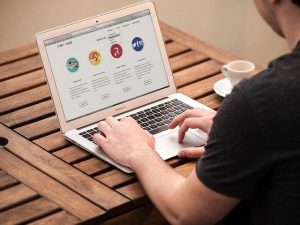Scroll depth tracking is a way to see how users are browsing and engaging with your web pages. It’s not quite the same but it’s a good alternative to heatmap software. Scroll depth is a term that is used to describe how long someone spends on a webpage before they scroll.
Tracking scroll depth can help you understand how visitors behave and by analyzing the data, make adjustments to their site for better user engagement.
CONFIGURING SCROLL DEPTH TRACKING
You can set up specific scroll depth percentages for the trigger in Google Tag Manager to look for as users scroll to a certain point on your web pages. Once users hit these scroll depth percentages on the webpage, Google Tag Manager will fire the event tag and send the data to Google Analytics.
If the scroll depth percentage that you specified is visible in the viewport when the page loads, the trigger will fire even if the user doesn’t scroll. The trigger will only fire once per threshold per page.
CONSIDERATIONS FOR SCROLL DEPTH TRACKING
There are special situations to consider when configuring your scroll depth tracking in Google Tag Manager. You may need to use additional configuration or different tracking for these scenarios:
-minimal scroll and non-interaction events
-infinite scroll pages
-anchor links to a specific section on pages
-single-page apps
MINIMAL SCROLL DEPTH TRACKING
Your page might be shorter so you might want to remove some of these lower scroll depth percentages, like 25%, in your trigger. Depending on how long your page is or the height of your page if you want to you might want to consider removing 50% as well but that’s up to you.
![]()
You don’t have to add zero to the percentages because whenever a page loads then this trigger would automatically fire. Even without the user scrolling, the page will always be at at least zero percent scroll depth. That won’t tell you much.
You’ll want to consider for your own website whether you want to add lower percentages. For example, five, ten, and even 25 percent, you want to figure out what your minimal scroll depth percent would be. What scroll depth percent would you want to count that as an engaged session?
NON-INTERACTION HIT
Another thing you want to consider is the non-interaction hit. That setting will affect the bounce rate.
![]()
By default, non-interaction hit is set to false. That means Google Analytics will count this as an interaction if the engagement from the user matches the condition for the trigger. Google Analytics will not count this as a bounce if users only view that single page and do nothing else but just scroll.
If you have a content or an informational site, you can use scroll tracking and keep this non-interaction hit field set to false. That way your bounce rate metric will speak more accurately to the engagement of the users.
INFINITE SCROLLING
Some websites have infinite scrolling where if a user scrolls to the bottom of the page, then more content will load each time the user does so. For that scenario, an element visibility trigger would be more appropriate.
SCROLL DEPTH TRACKING WITH ANCHOR LINKS
Some web pages have anchor links to specific sections on pages. For example, if you have an anchor link that goes to a section of the page that is 75% down the page, be aware that the trigger will fire for each of the percentages that you included in the trigger. That means 25% and 50% will send events for each of those percentages to Google Analytics.
SCROLL DEPTH TRACKING WITH SINGLE-PAGE WEB APP
If you have a single page web app and you’re using Google Tag Manager for page tracking, that means you’re using a history change trigger. You’ll also need to consider this for scroll tracking because when a user navigates to another URL the page doesn’t actually load a new page.
The history change trigger tells Google Analytics that the user actually navigated to a new URL so that’s something you want to consider. You may need to group your scroll depth trigger with a history change trigger.
CONCLUSION
Scroll depth tracking is a very helpful way to gauge user engagement and how users respond to the flow of your content. It can provide you with visibility into user insights on what they have seen and read, and where they need to go next.
This article originally appeared on Growth Learner and has been republished with permission.
Digital & Social Articles on Business 2 Community
(60)
Report Post





